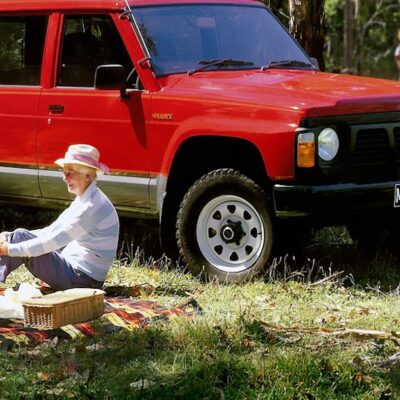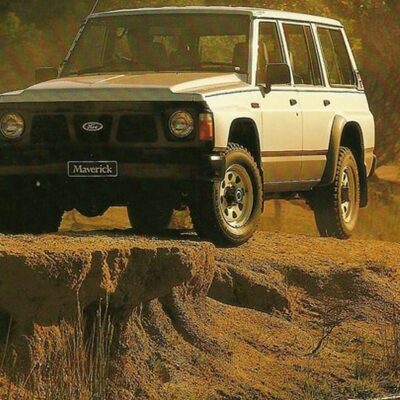1969-1977: The Original Ford Maverick
The Maverick started as a two-door coupe for 1969 in the wake of the Ford Mustang, a compact aimed at small imported cars like the Volkswagen Beetle and models from Datsun and Toyota that quickly captured the small car market. It had Mustang-like styling, a Mustang-like name (every Mustang is a Maverick horse), and ended up with Mustang-like popularity. Ford sold close to 600,000 units the first year, three times the volume of Mustang sold in 1970.
The name comes from a rancher famous for his unbranded livestock, his herd appeared to belong to no one, but Ford opted to use a longhorn cattle-inspired badge. The first Maverick was most notable for not having a glovebox which arrived four years later, around the same time as the four-door. Four-door car, not horse.
Smaller than the Falcon it replaced, the Maverick was a new direction for Ford. It moved the Blue Oval into a new segment, much like the new compact pickup should do in its own part of today’s market.
In the first half of production for the 1970 model, two engine options were available, a 105 hp (78 kW) 170 cu in straight-six and a 120 hp (89 kW) 200 cu in straight-six. A 250 cu in straight-six was added mid-year.
A four-door model was introduced for 1971, available with a vinyl roof. Mercury also revived the Comet as a rebadged variant of the Maverick. Also for 1971, an optional 210 hp (160 kW) 302 CID V8 was introduced for both the Comet and the Maverick. The Comet was distinguished from the Maverick by using a different grille, taillights, trim, and hood.
The Maverick Grabber trim package was introduced in mid-1970. In addition to larger tire fitment, the package included graphics and trim, including a spoiler. It was offered from 1970 to 1975. In 1971 and 1972, the Grabber came with a special “dual dome” hood.
Minor changes were made from 1973 to 1975. For 1973, the 170 CID engine was dropped, making the 200 CID I6 the standard engine. Additionally, improved brakes and a previously optional chrome grille became standard. An AM/FM stereo, aluminum wheels, and a slightly larger front bumper to comply with federal 5 MPH regulations were also standard. In 1974, the Maverick was unchanged except for new larger federally-required 5 MPH bumpers for both front and rear which required new rear quarter panel end caps.
The Maverick received minor trim changes for 1975 that included new grilles and the replacement of nameplates on the hood and trunk lid with Ford nameplates, in block letters.
In 1976, the Grabber was dropped, and a “Stallion” package was introduced. The Stallion option came with special paint and trim. Standard Mavericks received new grilles and gained front disc brakes as standard equipment along with new foot-operated parking brakes that replaced the old under-dash T-handle units.
The original Maverick car was built until 1977 for North America and two years longer in Brazil.
1988-1994: The Maverick Down Under
Next up in the history of the Ford Maverick badge was an effort to help save the Australian auto industry that saw automakers selling rebadged versions of other makes. Holden sold a Toyota, Toyota sold a Holden, and Ford sold the Nissan Patrol with a Maverick badge. It ran from 1988 through 1994, and it was the fourth-gen Patrol with some different badges and drum brakes.
This vehicle actually seems the most appropriate use of the Maverick name since it was just an unbranded Nissan rustled up by the Blue Oval down under.
1993-1999: Ford Maverick – Spain
Third in line to wear the Ford name and a Maverick badge was another rebranded Nissan. This strangely-shaped compact SUV was built by Nissan of Spain and called the Terrano II at the brand’s stores, where it was cheaper and had a longer warranty than the Ford version. Nissan sold this generation of the model from 1993 all the way to 2006, at which point it was extremely long in the tooth. Fortunately, Ford dropped the Maverick version for 1999.
In 1996, the car was facelifted, gaining round headlights. In Australia, the Terrano II arrived late to the market, going on sale in April 1997. It was available only with a manual transmission; the lack of an automatic option limited its sales potential in that market.
In the beginning of 1999 the Ford Maverick was phased out.
Though a small and cheap model, it boasted a body-on-frame design letting the tiny off-roader take some serious punishment.
2000-2007: Ford Maverick – Europe
The fourth Ford Maverick was, once again, another vehicle with a new badge, but at least this one was in the family; A Ford Escape slash Mazda Tribute but with the Maverick namesake for Europe. This Maverick arrived in 2001 (with Mazda’s dash), still the early days for the compact crossover. This Maverick had a rugged appearance compared to what was available in Europe at the time.
It sold reasonably well, but even Ford realized that the name was an odd one that also wore the stigma of a sub-par, previous-generation model still produced and sold as a Nissan.
Ford’s European arm canned the Maverick nameplate for the second and final time in 2007. The second-generation Escape sold in America from 2008 to 2012 didn’t receive clearance to travel to Europe. Instead, the Maverick’s spot in the range was filled by the Kuga, a more car-like crossover designed specifically for European roads. In an odd twist of fate, the second-generation Kuga released in 2012 spawned the third-generation Escape on our shores.
More Photos:
Click the photos to enlarge.


















